Mangrove restoration
Mangrove restoration is about recovering the former situation; it is the regeneration of mangrove ecosystems in areas where they were previously situated.
|
Thema |
Waterveiligheid, Het kustsysteem |
|
Tags |
|
|
Downloads |
- INTRODUTION
- RELATED TOPICS AND DELTA FACTS
- STRATEGY: WORKING WITH NATURE
- SCHEMATIC
- TECHNICAL CHARACTERISTICS
- GOVERNANCE
- COSTS AND BENEFITS
- LESSONS LEARNED AND ONGOING STUDY
- KNOWLEDGE GAPS
- EXPERIENCES
Introduction
Mangrove forests are estuarine wetlands, the area where the river meets the sea. Mangroves are forests in intertidal areas, with medium height trees and shrubs. They are located mostly along tropical coastlines and some subtropical coastlines (see figure 1). Mangroves flourish by a depositional regime of fine sediments. Situated between land and sea, the mangrove forest contains many different species which, depending on their location, are more or less salt tolerant. Mangroves are capable of protecting the coastline against erosion caused by wind, waves, and currents, and they can reduce the impact of storms and hurricanes. Mangroves include about 16 families and 40 to 50 species, but depending on the classification 100 species can be counted (Ellison, 2000; Christensen, 1983). Factors that influence the location of mangrove growth are the climate, tidal fluctuation, sedimentation, salinity and wave energy. This also influences the specific mangrove species that will grow at this location (McKee, 2002).
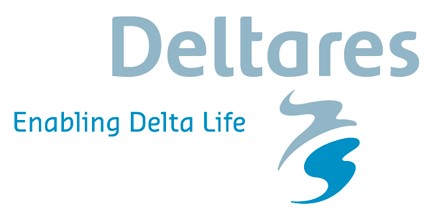

Mangrove restoration is an activity that fits well in the working with nature concept because mangrove forests serve as natural coastal defence. In the past decades a lot of experience has been gained with mangrove restoration in tropical areas. For example, in Bangladesh 120,000 ha of mangroves have been planted since 1968 (Saenger & Siddiqi, 1993).
Many mangrove forests were lost during the last decades of the 20th century. There are different reasons for the reduction of mangroves. These are human-induced degradation and natural disturbance related. Human-induced degradation is the active conversion of mangroves by humans, while natural disturbance is degradation of mangroves as a result of a change in their environment/ecology (which can have a human cause as well) (Biswas et al, 2009).
Biswas et al., (2009) identify 5 major causes:
- Conversion to shrimp /aquaculture farms
- Conversion to sea salt farms
- Conversion to agriculture
- Natural calamities
- Infrastructure development and hydrological diversion. There is a massive mangrove die-back due to changes in the hydrological system, which is sometimes caused by natural events, but is more often the result of human interference with the natural hydrology (Erftemijer and Teunissen, 2009).
Mangrove restoration is about recovering the former situation; it is the regeneration of mangrove ecosystems in areas where they were previously situated.
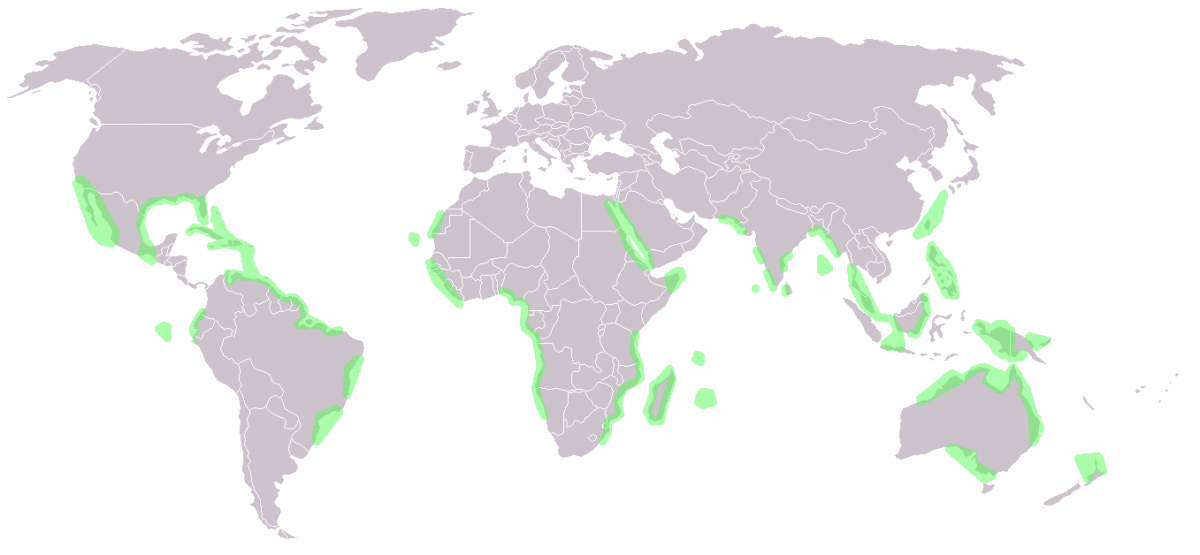
Figure 1. World mangrove distribution in 2000 (Wikipedia, 2013)
Related topics and Delta Facts
Key words: Mangroves, working with nature
Delta Facts: Sand Nourishment, Managed Realignment
Strategy: working with nature
Mangrove restoration is based on a strategy of ‘working with nature’. Working-with-nature is an approach in which optimal use is made of natural dynamics such as wind, water, sediment and vegetation and may lead to a positive effect on nature. Working with Nature solutions contribute to multifunctional land use, such as nature development, flood risk management, fresh water supply, fisheries, recreation and infrastructure.
The use of natural dynamics leads to solutions which are more adaptable in anticipating to (uncertain) changing, natural or socio-economic conditions. On the other hand, natural dynamics are inherently less predictable due to variability of weather conditions but also the complexity of ecological and morphological processes. Therefore working with nature solutions require adaptive pathways for decision-making and an adaptive governance approach to facilitate implementation and maintenance of the working-with-nature solutions. Adaptive pathways include the use of multiple scenarios on future socio-economic and physical developments (e.g. climate change or land-use) and possible actions. An adaptive governance approach includes principles of continuous and collective learning to include new insights and knowledge, a participatory monitoring program, wide participation of stakeholders, and a continues process of reflexive decision-making. This is contrary to more conventional approaches where after implementation projects are finished. The dynamic and unpredictable character of working with nature solutions, require a continuous process of decision-making.
Similar concepts to working with nature are ‘building with nature’, ‘eco-engineering’, ‘ecological enhancement’ and other.
Schematic
The mangrove ecosystem consists of a lot of benefits and values (figure 2). Reduction/degradation of the mangrove forest results in a loss of these ecosystem functions.
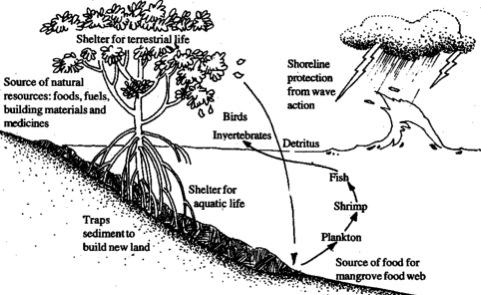
- Figure 2. Schematic representation of the benefits of mangroves (CoastvsErosion, 2013)
Technical characteristics
Restoration is defined as ‘an act of putting or bringing back into a former, normal, or unimpaired state or condition’. Restoration of ecosystems will seldom reach this initial stage, but it will more often mean returning the ecosystem to a state of effectiveness (Bosire et al, 2001). Morrison (1990) defines restoration as follows: ”restoration is the re-introduction and re-establishment of community-like groupings of native species to sites which can reasonably be expected to sustain them, with the resultant vegetation demonstrating aesthetic and dynamic characteristics of the natural communities on which they are based”. Restoration goals and objectives can vary, the primary goal often being re-establishment of habitat and functions that have been or would otherwise be lost. Other objectives could be landscape enhancement, sustainable productions of natural resources and protection of coastal areas (Morrisson, 1990).
There are various strategies for mangrove restoration. Lewis, R. (2001), studied mangrove restoration activities and divided these into three categories:
- Planting alone; this restoration usually fails because of lack of attention for the physiological tolerances of mangroves to tidal inundation. The reasons for degradation in the first place are often not taken into account and restored before the planting activities start.
- Hydrologic restoration (with and without planting). Proper planning increases the success rate in this case. Planting is only necessary if natural recolonization after the hydrologic restoration fails. Scientific data shows that when this method is used, the ecological functions of the mangrove forest are quickly restored. Natural regeneration is preferred, as the resulted forest is supposed to be more like the original forest (Field, 1998).
- Excavation or fill; In order for mangroves to grow, the restoration site needs to have a certain slope and a very exact tidal elevation to insure that the hydrology for the mangroves is correct. This takes a lot of preparation, work and with that money, making this restoration strategy not that feasible. Only in more developed countries this type of mangrove restoration activities could possibly be performed (Lewis, 2001).
For successful mangrove restoration the following six steps are identified. Work together with communities, organizations and local government in order to:
- Understand the ecology of the naturally occurring mangrove species at the site such as the patterns of reproduction, distribution, and successful seeding establishment.
- Understand the normal local hydrology that controls the distribution, settlement and growth of mangrove species.
- Estimate the modifications of the mangrove environment that occurred and that currently prevent natural secondary succession.
- Select appropriate restoration areas through application of step 1-3 above, that are both likely to succeed in rehabilitating a forest ecosystem and are cost effective. This step includes resolving land ownership/use issues necessary for ensuring long-term access to and conservation of the site.
- Design the restoration program at suitable sites (selected in step 4) to restore the proper hydrology and utilize natural mangrove recruitment for natural development.
- Utilize actual planting of propagules or seedlings only when step 1-5 does not work out and natural recruitment will not provide the quantity of successfully established seedlings, rate of stabilization or rate of growth as required for project success.
(Ecological Mangrove Restoration, 2007)
The success of restoration through replanting largely depends on the availability of suitable sites and species (Walters et al., 2008). In addition, a crucial condition for successful restoration of mangrove forests is the support and involvement of the local community.
With regard to the presence of suitable sites, it should be noted that clear-cutting of mangrove forests has often led to degradation and erosion of the soil. Due to the loss of live mangrove roots the soil may become unable to host plants at all. This makes it very difficult to restore the mangrove forests.
Mangrove forests are situated in the intertidal area between land and sea. The protective function of mangrove forest can be split up in wave attenuation, windbreak and stabilization of the shoreline by retaining sediment (Marchand, 2008). We elaborate on these three below.
Mangrove forests can realize significant wave attenuation. Especially in delta and coastal areas where a large natural belt of mangrove exists, a significant protection against storms is possible. Experiments and field observations have provided evidence for the wave attenuating function of mangrove vegetation. An illustrative example is the story of a village in India’s province Tamil Nadu, In an attempt to get in the Guinness World Records book the inhabitants planted 80.244 saplings of mangroves. This created a kilometre wide belt of trees of various varieties. When the tsunami struck at the 26 of December 2002, much of the land around the village was flooded, but this village suffered only minimal damage.
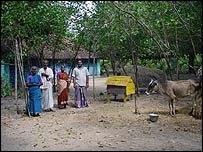
Storm protection can be realized through windbreak whereby mangrove trees are able to reduce wind speeds up to a distance about 20-30 times their height. The larger and closer the forest, the greater the impact on the wind velocities.
The tidal movement of water is not disturbed by breakwaters; it is actually the roots of the mangroves that reduce the velocity of the water and capture sediment. Suspended sediments that enters the mangrove ecosystem through waves, settles between the roots of the mangrove trees. Through this local sedimentation capitation, coastal erosion is diminished and with that stabilization of the shorelines takes place (Marchand, 2008).
Deltares is concerned with several mangrove restoration projects. The most important is the restoration of abiotic conditions that allow natural development of mangroves (interview B. van Weesenbeeck).
Governance
Many effective mangrove restoration projects, like the mentioned one in South India, have been conducted through an approach of ‘learning by doing’. Using this approach, communities implement mangrove restoration on a local scale with improved understanding of the factors influencing mangrove restoration, so failures can be minimized, costs are low, and implementation is sustainable. The advantage of this approach is that it is supported by the local population. These activities are initiated from bottom up.
Large scale restoration activities are happening less. There is a big step to be made to upscale small restoration activities. For example, to gain successful mangrove restoration at a larger scale and to limit uncoordinated fragmented initiatives it is necessary for governments to develop proactive coastal management plans to protect, enhance, restore and create mangrove forests. The recovery and protection of mangroves can be increased by these plans, in which not only the ecological issues are taken into account, but also the economic and social issues (Biswas et al, 2009). Such a plan can only be implemented successfully when the local community is aware of the benefits offered by mangrove forests; the lack of public awareness of the usefulness of mangrove forests for flood and erosion protection may hinder the realization of these plans. So very often there is a need for education and training of local people and parties.
The human factor in mangrove restoration should not be underestimated (Bosire et al., 2008). Biswas et al., (2009) for example state that poor socio-economic conditions and intensive human intervention are enormous challenges for mangrove restoration in Southeast Asia. To ensure that the mangrove forests are maintained and used in a sustainable manner (for example not torn or cut), local people and local stakeholders have to be involved in shoreline management. This will preserve habitats and ecosystems into the future. This will also reduce or even avoid the cost of restoration and planting schemes.
Costs and benefits
Costs of mangrove restoration
The costs of mangrove restoration differ per type of mangrove restoration activity (as proposed by R. Lewis (2001));
- Planting alone; inexpensive, from 100-200USD/ha.
- Hydrologic restoration (with and without planting). This can be done for the same costs as planting alone.
- Excavation or fill; this is a very expensive category, due to the high cost related to earthmoving on a large scale.
The costs of mangrove restoration further depend on:
- Type and location of mangrove/wetland to be restored, expertise availability, and consequent chances of success
- Degree of mangrove/wetland degradation and consequent restoration requirements
- Intended degree of restoration (for example, it may not be possible to restore all the ecosystem functions of a wetland if it is located in a highly industrialised/urbanised environment and the planned restoration measures may be less ambitious)
- Land costs if land purchase is required to convert to wetlands
- Labour costs of the restoration and monitoring activities.
- Transportation distance between seedling source and planting site
- Seedling mortality rate between collection and planting
- Cost of raising specific species in nurseries before transplantation because they cannot be directly planted on mud flats due to strong wind and wave forces
- Scale of post-implementation monitoring operations
Clearly, estimating the costs of mangrove restoration is complex and depends on a large number of factors. The costs of individual projects should be calculated on a case-by-case basis (Tri et al., 1998). A study by these authors calculated the costs and benefits of a mangrove restoration project in Vietnam.
This project involved the expansion of an existing mangrove forest on the seaward side of a dike system estimated planting capital and recurrent costs at approximately US$41 per hectare of mangrove planted, at 2009 price levels. This estimate includes planting costs and the cost of thinning (removal of certain plants to improve the growth rate and health of the remaining plants) from year six onwards. (Tri et al., 1998)
Benefits of mangrove restoration
Mangroves are very productive eco-systems; they provide benefits in different ways for many parties. These benefits can be in the direct use of harvesting the mangrove ecosystem natural resources:
- Forestry
- Fish production
- Agriculture
- Fuel production
- Harvestable goods
- Transport function
- Recreation and Tourism
Indirect use is more difficult to express in a monetary value, these are:
- Flow regulation and flood mitigation
- Prevention of saline water intrusion
- Sediment retention
- Nutrient retention and biological filter
- Toxicant removal or retention
- Protection against natural forces
- Wildlife and fish habitat
- External support (for neighbouring ecosystems)
- Scientific research and education (botanical interest)
The last benefit category is non-use or preservation value. These are the intangible values of the mangrove ecosystem, which are valued by a group within society (intrinsic):
- Biologic diversity
- Gene bank function
- Cultural and historic value
- Aesthetic value
- Wilderness value
- Uniqueness value
(ATC Engineering Consultants, 1994)
These different kinds of values create a certain “willingness to pay” for the above mentioned costs.
Commercial exploitation of the different function of mangroves can play a role in the restoration activities. Different parties can use the mangrove ecosystem as a resource for producing products and services. This is an incentive for them to invest in mangrove restoration and conservation. Different value drivers can be translated from the above mentioned values, for example: sustainable shrimp farming, commercial charcoal production, carbon capture for compensation, tourism opportunities. Business models around these value drivers that take into account ecological, social and economic factors can increase the success rate of large scale mangrove restoration activities (CANVAS workshop, 2013).
Lessons learned and ongoing study
Physical
A lot of expertise on mangrove restoration has been gained during the past decades. The success of restoration through replanting seems to depend largely on availability of suitable sites and species and the involvement of the local community (Walters et al., 2008).
Governance
Next to the physical conditions, the governance setting around the restoration activities is very important. In the Building with Nature research program guidelines are created for governing eco-engineering projects. These relate to the involvement of local communities, the use of pilots, and adaptive management structure and learning-by-doing approaches.
On-going research
As stated before, much is learned by doing. Pilot projects are running in for example Indonesia will provide further insights.
Knowledge gaps
Physical
A constraint to successful implementation of mangrove restoration is an incomplete understanding of the ability of a clear-cut, degraded wetland to recover, and of the success rates of mangrove restoration. The most important is the restoration of abiotic conditions that allow natural development of mangroves. The needs of mangroves and other wetland plants and animals are not yet fully understood. Monitoring of completed schemes will enhance the understanding of the mangrove restoration (Climate tech wiki, 2013).
Governance
Additional research is needed to build successful business models around mangrove restoration. There are a lot of benefits related to mangrove restoration (as stated before), which could, in theory, be commercially exploited. These theoretical business models should be tested and further expanded.
There is a need to combine the technological, economic and social knowledge on mangrove restoration, to make mangrove restoration more successful (CANVAS workshop). On-going research and monitoring of current mangrove restoration projects can provide insight into the preconditions for successful mangrove restoration.
Local training to increase community understanding and awareness of mangrove values is needed.
Experiences
Wetlands International, IUCN Netherlands, Oxfam Novib – Sustianable Shrimp Production South East Asia.
Mangrove forests are threatened as they are converted for aquaculture on a large scale, particularly for shrimp ponds. These ponds are exhausted within a few years and after that abandoned as they are no longer useable.
Wetlands International, IUCN Netherlands and Oxfam Novib state that sustainable aquaculture production can help in restoring and conservation mangrove ecosystems. They work together with local partners in key mangrove countries, like Indonesia and Thailand, to promote this sustainable use.
The approach they offer, integrates sustainable use with commercial production and reduction of the vulnerability of coastal areas.
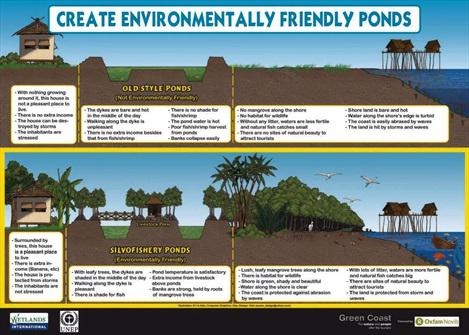

 English resume
English resume